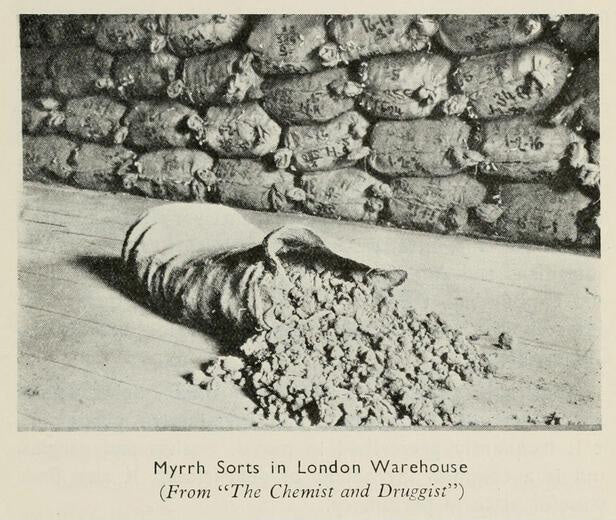
Unveiling the Rich Heritage of Yemeni Myrrh
Awaken To The OneShare
The Enigmatic Myrrh of Yemen: A Journey Through Tradition, Culture, and Craftsmanship
Myrrh, a fragrant resin revered for centuries, carries an air of mystery and deep cultural significance. Among the world's finest myrrh, Yemeni myrrh—locally known as “Murr”—stands out for its unparalleled quality, deeply rooted traditions, and the intricate craft of its harvesting. This resin has played a vital role in Yemen's history, culture, and economy, from its use in ancient rituals to its enduring significance today.
The Origins and Significance of Myrrh in Yemen
Myrrh comes from the Commiphora tree, a hardy species that thrives in Yemen's arid and unforgiving terrain. The country’s unique geography—its rugged mountains and expansive deserts—creates the perfect conditions for producing some of the highest-quality myrrh in the world. For thousands of years, Yemeni myrrh has been a prized commodity, sought after by ancient civilizations for its medicinal, spiritual, and cosmetic properties. The region’s role in the ancient incense trade route solidified its reputation as a hub of this fragrant treasure.
Yemeni myrrh is distinguished by its golden amber hue, rich aromatic scent, and medicinal potency. It has been used in everything from embalming rituals in ancient Egypt to anointing oils in religious ceremonies, and it continues to be highly valued in the global market.
The Art of Harvesting Myrrh
Harvesting myrrh is both an art and a labor-intensive craft, honed over generations by the skilled hands of Yemeni farmers. The process begins with the selection of mature Commiphora trees, which are often found in remote, rocky terrains. These trees must be meticulously cared for, as their survival depends on their ability to withstand Yemen’s harsh environment.
The harvesters make precise incisions in the bark of the tree using special tools. These cuts allow the tree to exude a sticky, milky sap, which gradually hardens into resin droplets. This process, known as “tapping,” requires patience and expertise, as the resin must be left to dry and crystallize on the tree for several weeks before it is collected.
Harvesting myrrh is no easy task. The trees are often located in remote and inaccessible areas, requiring harvesters to undertake long journeys by foot or donkey. The extreme heat, steep terrain, and the physical strain of collecting resin make this work grueling. Moreover, the trees themselves are sensitive; overharvesting or improper techniques can damage the tree, reducing future yields. This delicate balance reflects the deep respect Yemeni harvesters have for their environment.
The People Behind the Resin
The harvesting of myrrh is deeply intertwined with the lives of Yemen’s rural communities. Often passed down through families, the craft is steeped in tradition and cultural pride. For many harvesters, myrrh represents more than just an income—it is a connection to their heritage and the land they call home.
Despite their expertise, myrrh harvesters face significant challenges. The ongoing conflict in Yemen, coupled with economic instability, has made accessing global markets increasingly difficult. Many harvesters operate within informal networks, relying on middlemen to sell their resin. This often results in lower profits, leaving the harvesters with minimal financial security despite their arduous labor.
Cultural and Ritual Significance
Yemeni myrrh is deeply rooted in the region’s cultural and spiritual practices. In traditional Yemeni households, burning myrrh is a daily ritual. The aromatic smoke is believed to cleanse spaces, ward off negative energy, and create an atmosphere of tranquility. Myrrh is also used in traditional medicine, where it is valued for its anti-inflammatory, antiseptic, and wound-healing properties. Healers often mix myrrh with other herbs to create potent remedies for ailments ranging from digestive issues to skin conditions.
In addition to its medicinal uses, myrrh plays a central role in religious and ceremonial practices. It is often burned during weddings, funerals, and other important life events. The resin’s deep connection to spirituality and healing underscores its enduring importance in Yemeni culture.
The Challenges of the Modern Myrrh Trade
While Yemeni myrrh remains a highly sought-after product, the industry faces numerous obstacles. The ongoing conflict in Yemen has disrupted supply chains and limited access to international markets. As a result, many harvesters struggle to sell their resin at fair prices, threatening the livelihoods of entire communities.
Climate change poses an additional challenge, as rising temperatures and changing rainfall patterns put further stress on the already fragile Commiphora trees. Conservation efforts are essential to ensure the sustainability of Yemen’s myrrh industry, but such initiatives often lack the funding and support needed to make a significant impact.
Preserving Yemen’s Myrrh Legacy
Despite these challenges, there is hope for the future of Yemeni myrrh. Efforts to support local harvesters, promote fair trade practices, and raise awareness about the resin’s cultural significance are gaining traction. By investing in sustainable harvesting methods and creating direct trade opportunities, the global community can help preserve Yemen’s rich myrrh heritage for generations to come.
For those who seek to experience the mystique of Yemeni myrrh, purchasing directly from ethical sources ensures that your contribution supports the artisans and harvesters who work tirelessly to bring this ancient treasure to the world.
Conclusion
The story of myrrh in Yemen is one of resilience, tradition, and an unyielding connection to the land. From its painstaking harvest to its profound cultural significance, Yemeni myrrh is a testament to the enduring power of nature and human ingenuity. As the world becomes increasingly aware of the importance of preserving cultural heritage and natural resources, Yemeni myrrh stands as a symbol of the beauty and fragility of our shared history.
